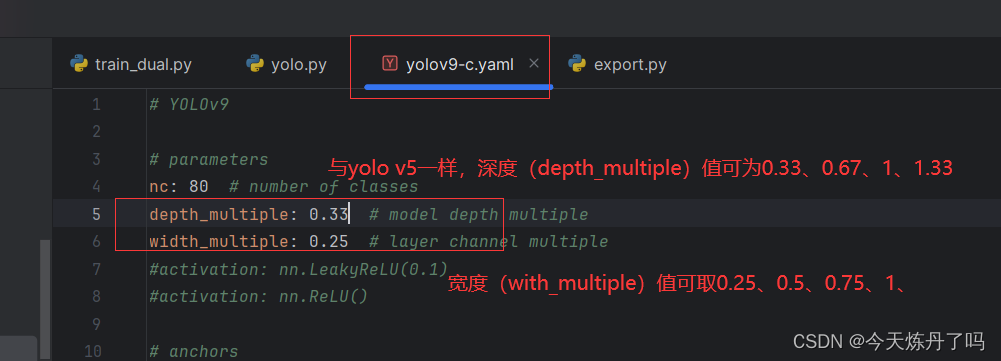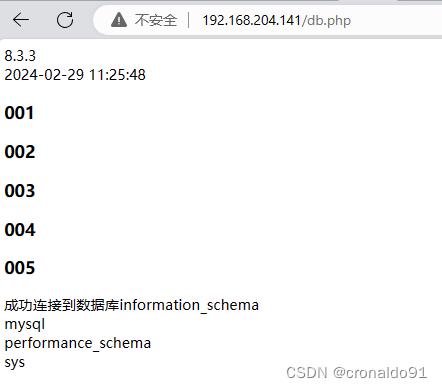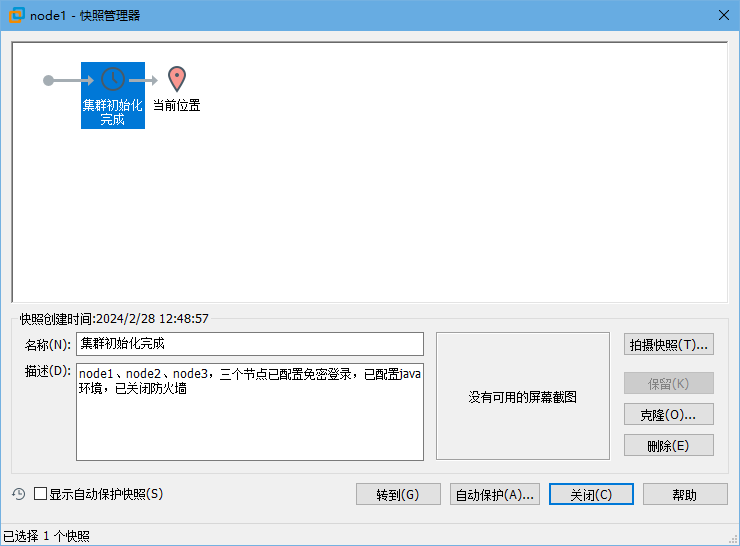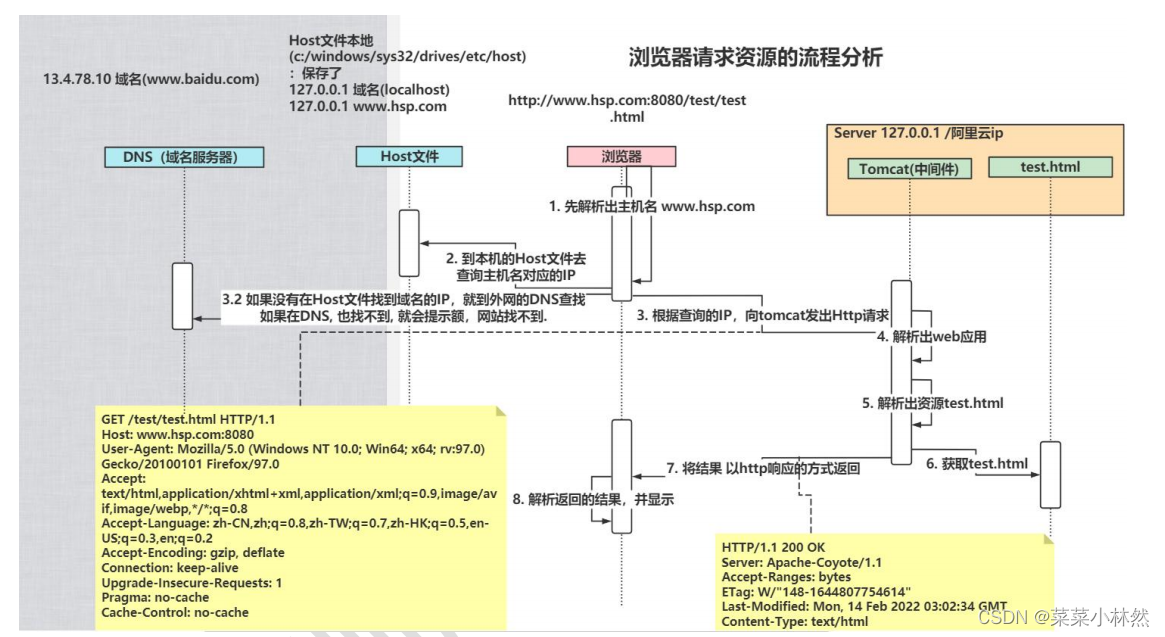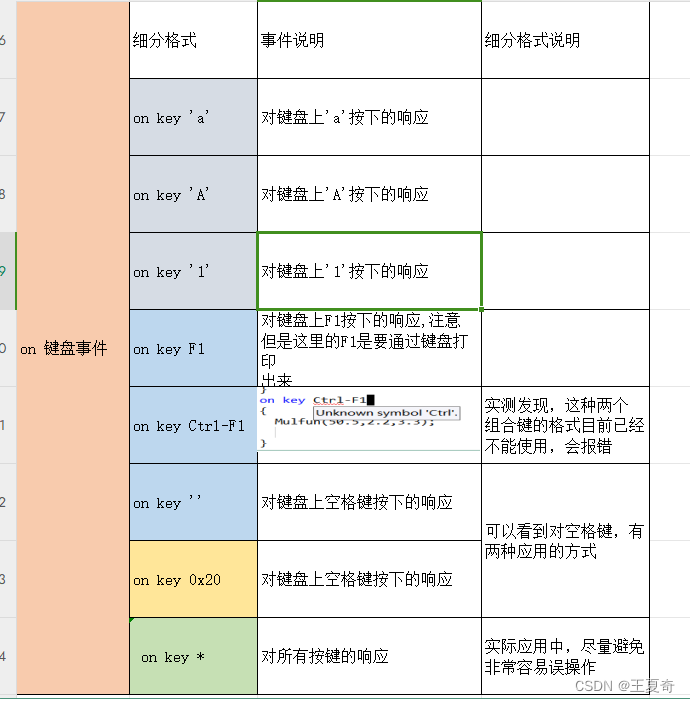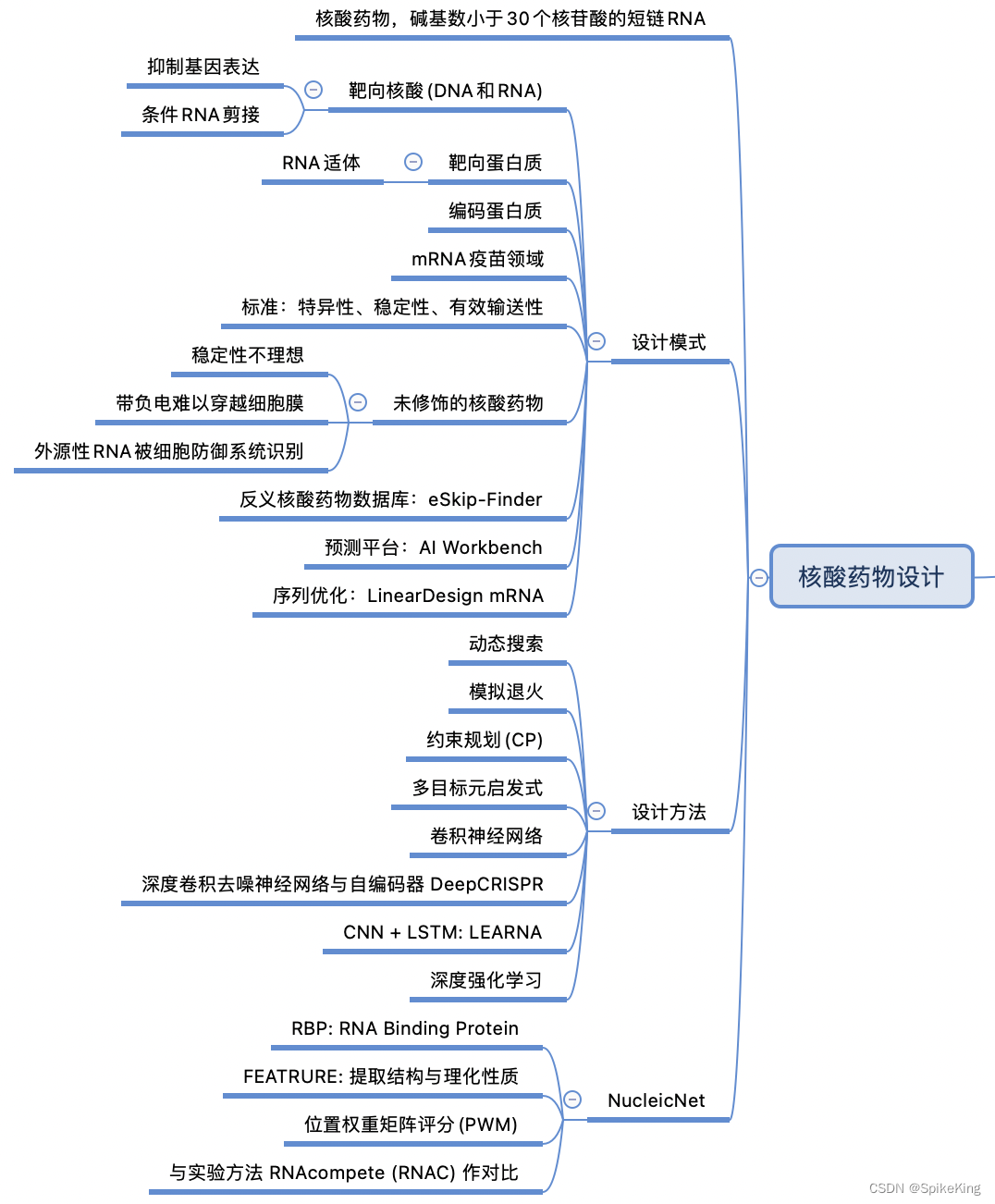一、代码及论文链接:
代码链接:GitHub - WongKinYiu/yolov9: Implementation of paper - YOLOv9: Learning What You Want to Learn Using Programmable Gradient Information
论文链接:https://github.com/WongKinYiu/yolov9/tree/main
二、 说明
本文方法并不能直接替代YOLOv9原作者尚未开源的两个小模型,但可以按比例减小模型尺寸。类似YOLOv5、v8等,可以方便测试YOLOv9在数据集上的性能!方法来源于网络。
三、使用步骤
参照之前的YOLOv9代码,我们运行yolov9-c.yaml的参数量是239 GLOPs。

我们将以下代码替换掉YOLOv9工程下models包下yolo.py脚本中的代码。
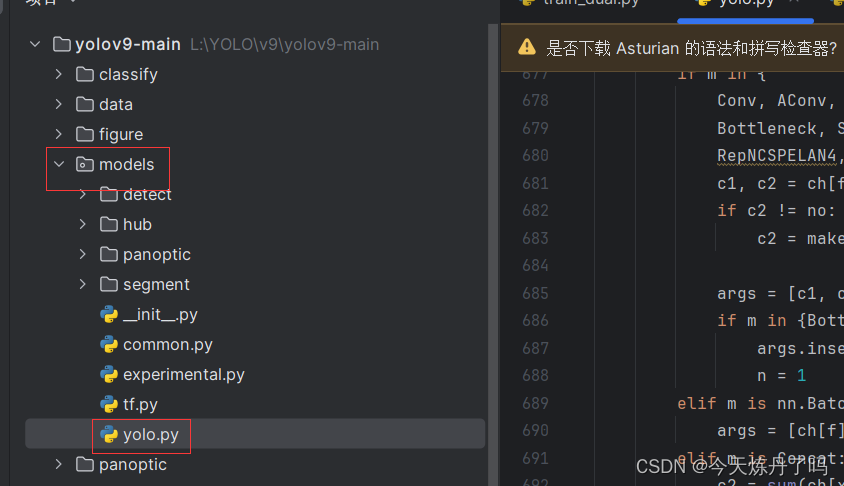
import argparse
import os
import platform
import sys
from copy import deepcopy
from pathlib import Path
FILE = Path(__file__).resolve()
ROOT = FILE.parents[1] # YOLO root directory
if str(ROOT) not in sys.path:
sys.path.append(str(ROOT)) # add ROOT to PATH
if platform.system() != 'Windows':
ROOT = Path(os.path.relpath(ROOT, Path.cwd())) # relative
from models.common import *
from models.experimental import *
from utils.general import LOGGER, check_version, check_yaml, make_divisible, print_args
from utils.plots import feature_visualization
from utils.torch_utils import (fuse_conv_and_bn, initialize_weights, model_info, profile, scale_img, select_device,
time_sync)
from utils.tal.anchor_generator import make_anchors, dist2bbox
try:
import thop # for FLOPs computation
except ImportError:
thop = None
class Detect(nn.Module):
# YOLO Detect head for detection models
dynamic = False # force grid reconstruction
export = False # export mode
shape = None
anchors = torch.empty(0) # init
strides = torch.empty(0) # init
def __init__(self, nc=80, ch=(), inplace=True): # detection layer
super().__init__()
self.nc = nc # number of classes
self.nl = len(ch) # number of detection layers
self.reg_max = 16
self.no = nc + self.reg_max * 4 # number of outputs per anchor
self.inplace = inplace # use inplace ops (e.g. slice assignment)
self.stride = torch.zeros(self.nl) # strides computed during build
c2, c3 = max((ch[0] // 4, self.reg_max * 4, 16)), max((ch[0], min((self.nc * 2, 128)))) # channels
self.cv2 = nn.ModuleList(
nn.Sequential(Conv(x, c2, 3), Conv(c2, c2, 3), nn.Conv2d(c2, 4 * self.reg_max, 1)) for x in ch)
self.cv3 = nn.ModuleList(
nn.Sequential(Conv(x, c3, 3), Conv(c3, c3, 3), nn.Conv2d(c3, self.nc, 1)) for x in ch)
self.dfl = DFL(self.reg_max) if self.reg_max > 1 else nn.Identity()
def forward(self, x):
shape = x[0].shape # BCHW
for i in range(self.nl):
x[i] = torch.cat((self.cv2[i](x[i]), self.cv3[i](x[i])), 1)
if self.training:
return x
elif self.dynamic or self.shape != shape:
self.anchors, self.strides = (x.transpose(0, 1) for x in make_anchors(x, self.stride, 0.5))
self.shape = shape
box, cls = torch.cat([xi.view(shape[0], self.no, -1) for xi in x], 2).split((self.reg_max * 4, self.nc), 1)
dbox = dist2bbox(self.dfl(box), self.anchors.unsqueeze(0), xywh=True, dim=1) * self.strides
y = torch.cat((dbox, cls.sigmoid()), 1)
return y if self.export else (y, x)
def bias_init(self):
# Initialize Detect() biases, WARNING: requires stride availability
m = self # self.model[-1] # Detect() module
# cf = torch.bincount(torch.tensor(np.concatenate(dataset.labels, 0)[:, 0]).long(), minlength=nc) + 1
# ncf = math.log(0.6 / (m.nc - 0.999999)) if cf is None else torch.log(cf / cf.sum()) # nominal class frequency
for a, b, s in zip(m.cv2, m.cv3, m.stride): # from
a[-1].bias.data[:] = 1.0 # box
b[-1].bias.data[:m.nc] = math.log(5 / m.nc / (640 / s) ** 2) # cls (5 objects and 80 classes per 640 image)
class DDetect(nn.Module):
# YOLO Detect head for detection models
dynamic = False # force grid reconstruction
export = False # export mode
shape = None
anchors = torch.empty(0) # init
strides = torch.empty(0) # init
def __init__(self, nc=80, ch=(), inplace=True): # detection layer
super().__init__()
self.nc = nc # number of classes
self.nl = len(ch) # number of detection layers
self.reg_max = 16
self.no = nc + self.reg_max * 4 # number of outputs per anchor
self.inplace = inplace # use inplace ops (e.g. slice assignment)
self.stride = torch.zeros(self.nl) # strides computed during build
c2, c3 = make_divisible(max((ch[0] // 4, self.reg_max * 4, 16)), 4), max((ch[0], min((self.nc * 2, 128)))) # channels
self.cv2 = nn.ModuleList(
nn.Sequential(Conv(x, c2, 3), Conv(c2, c2, 3, g=4), nn.Conv2d(c2, 4 * self.reg_max, 1, groups=4)) for x in ch)
self.cv3 = nn.ModuleList(
nn.Sequential(Conv(x, c3, 3), Conv(c3, c3, 3), nn.Conv2d(c3, self.nc, 1)) for x in ch)
self.dfl = DFL(self.reg_max) if self.reg_max > 1 else nn.Identity()
def forward(self, x):
shape = x[0].shape # BCHW
for i in range(self.nl):
x[i] = torch.cat((self.cv2[i](x[i]), self.cv3[i](x[i])), 1)
if self.training:
return x
elif self.dynamic or self.shape != shape:
self.anchors, self.strides = (x.transpose(0, 1) for x in make_anchors(x, self.stride, 0.5))
self.shape = shape
box, cls = torch.cat([xi.view(shape[0], self.no, -1) for xi in x], 2).split((self.reg_max * 4, self.nc), 1)
dbox = dist2bbox(self.dfl(box), self.anchors.unsqueeze(0), xywh=True, dim=1) * self.strides
y = torch.cat((dbox, cls.sigmoid()), 1)
return y if self.export else (y, x)
def bias_init(self):
# Initialize Detect() biases, WARNING: requires stride availability
m = self # self.model[-1] # Detect() module
# cf = torch.bincount(torch.tensor(np.concatenate(dataset.labels, 0)[:, 0]).long(), minlength=nc) + 1
# ncf = math.log(0.6 / (m.nc - 0.999999)) if cf is None else torch.log(cf / cf.sum()) # nominal class frequency
for a, b, s in zip(m.cv2, m.cv3, m.stride): # from
a[-1].bias.data[:] = 1.0 # box
b[-1].bias.data[:m.nc] = math.log(5 / m.nc / (640 / s) ** 2) # cls (5 objects and 80 classes per 640 image)
class DualDetect(nn.Module):
# YOLO Detect head for detection models
dynamic = False # force grid reconstruction
export = False # export mode
shape = None
anchors = torch.empty(0) # init
strides = torch.empty(0) # init
def __init__(self, nc=80, ch=(), inplace=True): # detection layer
super().__init__()
self.nc = nc # number of classes
self.nl = len(ch) // 2 # number of detection layers
self.reg_max = 16
self.no = nc + self.reg_max * 4 # number of outputs per anchor
self.inplace = inplace # use inplace ops (e.g. slice assignment)
self.stride = torch.zeros(self.nl) # strides computed during build
c2, c3 = max((ch[0] // 4, self.reg_max * 4, 16)), max((ch[0], min((self.nc * 2, 128)))) # channels
c4, c5 = max((ch[self.nl] // 4, self.reg_max * 4, 16)), max((ch[self.nl], min((self.nc * 2, 128)))) # channels
self.cv2 = nn.ModuleList(
nn.Sequential(Conv(x, c2, 3), Conv(c2, c2, 3), nn.Conv2d(c2, 4 * self.reg_max, 1)) for x in ch[:self.nl])
self.cv3 = nn.ModuleList(
nn.Sequential(Conv(x, c3, 3), Conv(c3, c3, 3), nn.Conv2d(c3, self.nc, 1)) for x in ch[:self.nl])
self.cv4 = nn.ModuleList(
nn.Sequential(Conv(x, c4, 3), Conv(c4, c4, 3), nn.Conv2d(c4, 4 * self.reg_max, 1)) for x in ch[self.nl:])
self.cv5 = nn.ModuleList(
nn.Sequential(Conv(x, c5, 3), Conv(c5, c5, 3), nn.Conv2d(c5, self.nc, 1)) for x in ch[self.nl:])
self.dfl = DFL(self.reg_max)
self.dfl2 = DFL(self.reg_max)
def forward(self, x):
shape = x[0].shape # BCHW
d1 = []
d2 = []
for i in range(self.nl):
d1.append(torch.cat((self.cv2[i](x[i]), self.cv3[i](x[i])), 1))
d2.append(torch.cat((self.cv4[i](x[self.nl+i]), self.cv5[i](x[self.nl+i])), 1))
if self.training:
return [d1, d2]
elif self.dynamic or self.shape != shape:
self.anchors, self.strides = (d1.transpose(0, 1) for d1 in make_anchors(d1, self.stride, 0.5))
self.shape = shape
box, cls = torch.cat([di.view(shape[0], self.no, -1) for di in d1], 2).split((self.reg_max * 4, self.nc), 1)
dbox = dist2bbox(self.dfl(box), self.anchors.unsqueeze(0), xywh=True, dim=1) * self.strides
box2, cls2 = torch.cat([di.view(shape[0], self.no, -1) for di in d2], 2).split((self.reg_max * 4, self.nc), 1)
dbox2 = dist2bbox(self.dfl2(box2), self.anchors.unsqueeze(0), xywh=True, dim=1) * self.strides
y = [torch.cat((dbox, cls.sigmoid()), 1), torch.cat((dbox2, cls2.sigmoid()), 1)]
return y if self.export else (y, [d1, d2])
def bias_init(self):
# Initialize Detect() biases, WARNING: requires stride availability
m = self # self.model[-1] # Detect() module
# cf = torch.bincount(torch.tensor(np.concatenate(dataset.labels, 0)[:, 0]).long(), minlength=nc) + 1
# ncf = math.log(0.6 / (m.nc - 0.999999)) if cf is None else torch.log(cf / cf.sum()) # nominal class frequency
for a, b, s in zip(m.cv2, m.cv3, m.stride): # from
a[-1].bias.data[:] = 1.0 # box
b[-1].bias.data[:m.nc] = math.log(5 / m.nc / (640 / s) ** 2) # cls (5 objects and 80 classes per 640 image)
for a, b, s in zip(m.cv4, m.cv5, m.stride): # from
a[-1].bias.data[:] = 1.0 # box
b[-1].bias.data[:m.nc] = math.log(5 / m.nc / (640 / s) ** 2) # cls (5 objects and 80 classes per 640 image)
class DualDDetect(nn.Module):
# YOLO Detect head for detection models
dynamic = False # force grid reconstruction
export = False # export mode
shape = None
anchors = torch.empty(0) # init
strides = torch.empty(0) # init
def __init__(self, nc=80, ch=(), inplace=True): # detection layer
super().__init__()
self.nc = nc # number of classes
self.nl = len(ch) // 2 # number of detection layers
self.reg_max = 16
self.no = nc + self.reg_max * 4 # number of outputs per anchor
self.inplace = inplace # use inplace ops (e.g. slice assignment)
self.stride = torch.zeros(self.nl) # strides computed during build
c2, c3 = make_divisible(max((ch[0] // 4, self.reg_max * 4, 16)), 4), max((ch[0], min((self.nc * 2, 128)))) # channels
c4, c5 = make_divisible(max((ch[self.nl] // 4, self.reg_max * 4, 16)), 4), max((ch[self.nl], min((self.nc * 2, 128)))) # channels
self.cv2 = nn.ModuleList(
nn.Sequential(Conv(x, c2, 3), Conv(c2, c2, 3, g=4), nn.Conv2d(c2, 4 * self.reg_max, 1, groups=4)) for x in ch[:self.nl])
self.cv3 = nn.ModuleList(
nn.Sequential(Conv(x, c3, 3), Conv(c3, c3, 3), nn.Conv2d(c3, self.nc, 1)) for x in ch[:self.nl])
self.cv4 = nn.ModuleList(
nn.Sequential(Conv(x, c4, 3), Conv(c4, c4, 3, g=4), nn.Conv2d(c4, 4 * self.reg_max, 1, groups=4)) for x in ch[self.nl:])
self.cv5 = nn.ModuleList(
nn.Sequential(Conv(x, c5, 3), Conv(c5, c5, 3), nn.Conv2d(c5, self.nc, 1)) for x in ch[self.nl:])
self.dfl = DFL(self.reg_max)
self.dfl2 = DFL(self.reg_max)
def forward(self, x):
shape = x[0].shape # BCHW
d1 = []
d2 = []
for i in range(self.nl):
d1.append(torch.cat((self.cv2[i](x[i]), self.cv3[i](x[i])), 1))
d2.append(torch.cat((self.cv4[i](x[self.nl+i]), self.cv5[i](x[self.nl+i])), 1))
if self.training:
return [d1, d2]
elif self.dynamic or self.shape != shape:
self.anchors, self.strides = (d1.transpose(0, 1) for d1 in make_anchors(d1, self.stride, 0.5))
self.shape = shape
box, cls = torch.cat([di.view(shape[0], self.no, -1) for di in d1], 2).split((self.reg_max * 4, self.nc), 1)
dbox = dist2bbox(self.dfl(box), self.anchors.unsqueeze(0), xywh=True, dim=1) * self.strides
box2, cls2 = torch.cat([di.view(shape[0], self.no, -1) for di in d2], 2).split((self.reg_max * 4, self.nc), 1)
dbox2 = dist2bbox(self.dfl2(box2), self.anchors.unsqueeze(0), xywh=True, dim=1) * self.strides
y = [torch.cat((dbox, cls.sigmoid()), 1), torch.cat((dbox2, cls2.sigmoid()), 1)]
return y if self.export else (y, [d1, d2])
#y = torch.cat((dbox2, cls2.sigmoid()), 1)
#return y if self.export else (y, d2)
#y1 = torch.cat((dbox, cls.sigmoid()), 1)
#y2 = torch.cat((dbox2, cls2.sigmoid()), 1)
#return [y1, y2] if self.export else [(y1, d1), (y2, d2)]
#return [y1, y2] if self.export else [(y1, y2), (d1, d2)]
def bias_init(self):
# Initialize Detect() biases, WARNING: requires stride availability
m = self # self.model[-1] # Detect() module
# cf = torch.bincount(torch.tensor(np.concatenate(dataset.labels, 0)[:, 0]).long(), minlength=nc) + 1
# ncf = math.log(0.6 / (m.nc - 0.999999)) if cf is None else torch.log(cf / cf.sum()) # nominal class frequency
for a, b, s in zip(m.cv2, m.cv3, m.stride): # from
a[-1].bias.data[:] = 1.0 # box
b[-1].bias.data[:m.nc] = math.log(5 / m.nc / (640 / s) ** 2) # cls (5 objects and 80 classes per 640 image)
for a, b, s in zip(m.cv4, m.cv5, m.stride): # from
a[-1].bias.data[:] = 1.0 # box
b[-1].bias.data[:m.nc] = math.log(5 / m.nc / (640 / s) ** 2) # cls (5 objects and 80 classes per 640 image)
class TripleDetect(nn.Module):
# YOLO Detect head for detection models
dynamic = False # force grid reconstruction
export = False # export mode
shape = None
anchors = torch.empty(0) # init
strides = torch.empty(0) # init
def __init__(self, nc=80, ch=(), inplace=True): # detection layer
super().__init__()
self.nc = nc # number of classes
self.nl = len(ch) // 3 # number of detection layers
self.reg_max = 16
self.no = nc + self.reg_max * 4 # number of outputs per anchor
self.inplace = inplace # use inplace ops (e.g. slice assignment)
self.stride = torch.zeros(self.nl) # strides computed during build
c2, c3 = max((ch[0] // 4, self.reg_max * 4, 16)), max((ch[0], min((self.nc * 2, 128)))) # channels
c4, c5 = max((ch[self.nl] // 4, self.reg_max * 4, 16)), max((ch[self.nl], min((self.nc * 2, 128)))) # channels
c6, c7 = max((ch[self.nl * 2] // 4, self.reg_max * 4, 16)), max((ch[self.nl * 2], min((self.nc * 2, 128)))) # channels
self.cv2 = nn.ModuleList(
nn.Sequential(Conv(x, c2, 3), Conv(c2, c2, 3), nn.Conv2d(c2, 4 * self.reg_max, 1)) for x in ch[:self.nl])
self.cv3 = nn.ModuleList(
nn.Sequential(Conv(x, c3, 3), Conv(c3, c3, 3), nn.Conv2d(c3, self.nc, 1)) for x in ch[:self.nl])
self.cv4 = nn.ModuleList(
nn.Sequential(Conv(x, c4, 3), Conv(c4, c4, 3), nn.Conv2d(c4, 4 * self.reg_max, 1)) for x in ch[self.nl:self.nl*2])
self.cv5 = nn.ModuleList(
nn.Sequential(Conv(x, c5, 3), Conv(c5, c5, 3), nn.Conv2d(c5, self.nc, 1)) for x in ch[self.nl:self.nl*2])
self.cv6 = nn.ModuleList(
nn.Sequential(Conv(x, c6, 3), Conv(c6, c6, 3), nn.Conv2d(c6, 4 * self.reg_max, 1)) for x in ch[self.nl*2:self.nl*3])
self.cv7 = nn.ModuleList(
nn.Sequential(Conv(x, c7, 3), Conv(c7, c7, 3), nn.Conv2d(c7, self.nc, 1)) for x in ch[self.nl*2:self.nl*3])
self.dfl = DFL(self.reg_max)
self.dfl2 = DFL(self.reg_max)
self.dfl3 = DFL(self.reg_max)
def forward(self, x):
shape = x[0].shape # BCHW
d1 = []
d2 = []
d3 = []
for i in range(self.nl):
d1.append(torch.cat((self.cv2[i](x[i]), self.cv3[i](x[i])), 1))
d2.append(torch.cat((self.cv4[i](x[self.nl+i]), self.cv5[i](x[self.nl+i])), 1))
d3.append(torch.cat((self.cv6[i](x[self.nl*2+i]), self.cv7[i](x[self.nl*2+i])), 1))
if self.training:
return [d1, d2, d3]
elif self.dynamic or self.shape != shape:
self.anchors, self.strides = (d1.transpose(0, 1) for d1 in make_anchors(d1, self.stride, 0.5))
self.shape = shape
box, cls = torch.cat([di.view(shape[0], self.no, -1) for di in d1], 2).split((self.reg_max * 4, self.nc), 1)
dbox = dist2bbox(self.dfl(box), self.anchors.unsqueeze(0), xywh=True, dim=1) * self.strides
box2, cls2 = torch.cat([di.view(shape[0], self.no, -1) for di in d2], 2).split((self.reg_max * 4, self.nc), 1)
dbox2 = dist2bbox(self.dfl2(box2), self.anchors.unsqueeze(0), xywh=True, dim=1) * self.strides
box3, cls3 = torch.cat([di.view(shape[0], self.no, -1) for di in d3], 2).split((self.reg_max * 4, self.nc), 1)
dbox3 = dist2bbox(self.dfl3(box3), self.anchors.unsqueeze(0), xywh=True, dim=1) * self.strides
y = [torch.cat((dbox, cls.sigmoid()), 1), torch.cat((dbox2, cls2.sigmoid()), 1), torch.cat((dbox3, cls3.sigmoid()), 1)]
return y if self.export else (y, [d1, d2, d3])
def bias_init(self):
# Initialize Detect() biases, WARNING: requires stride availability
m = self # self.model[-1] # Detect() module
# cf = torch.bincount(torch.tensor(np.concatenate(dataset.labels, 0)[:, 0]).long(), minlength=nc) + 1
# ncf = math.log(0.6 / (m.nc - 0.999999)) if cf is None else torch.log(cf / cf.sum()) # nominal class frequency
for a, b, s in zip(m.cv2, m.cv3, m.stride): # from
a[-1].bias.data[:] = 1.0 # box
b[-1].bias.data[:m.nc] = math.log(5 / m.nc / (640 / s) ** 2) # cls (5 objects and 80 classes per 640 image)
for a, b, s in zip(m.cv4, m.cv5, m.stride): # from
a[-1].bias.data[:] = 1.0 # box
b[-1].bias.data[:m.nc] = math.log(5 / m.nc / (640 / s) ** 2) # cls (5 objects and 80 classes per 640 image)
for a, b, s in zip(m.cv6, m.cv7, m.stride): # from
a[-1].bias.data[:] = 1.0 # box
b[-1].bias.data[:m.nc] = math.log(5 / m.nc / (640 / s) ** 2) # cls (5 objects and 80 classes per 640 image)
class TripleDDetect(nn.Module):
# YOLO Detect head for detection models
dynamic = False # force grid reconstruction
export = False # export mode
shape = None
anchors = torch.empty(0) # init
strides = torch.empty(0) # init
def __init__(self, nc=80, ch=(), inplace=True): # detection layer
super().__init__()
self.nc = nc # number of classes
self.nl = len(ch) // 3 # number of detection layers
self.reg_max = 16
self.no = nc + self.reg_max * 4 # number of outputs per anchor
self.inplace = inplace # use inplace ops (e.g. slice assignment)
self.stride = torch.zeros(self.nl) # strides computed during build
c2, c3 = make_divisible(max((ch[0] // 4, self.reg_max * 4, 16)), 4), \
max((ch[0], min((self.nc * 2, 128)))) # channels
c4, c5 = make_divisible(max((ch[self.nl] // 4, self.reg_max * 4, 16)), 4), \
max((ch[self.nl], min((self.nc * 2, 128)))) # channels
c6, c7 = make_divisible(max((ch[self.nl * 2] // 4, self.reg_max * 4, 16)), 4), \
max((ch[self.nl * 2], min((self.nc * 2, 128)))) # channels
self.cv2 = nn.ModuleList(
nn.Sequential(Conv(x, c2, 3), Conv(c2, c2, 3, g=4),
nn.Conv2d(c2, 4 * self.reg_max, 1, groups=4)) for x in ch[:self.nl])
self.cv3 = nn.ModuleList(
nn.Sequential(Conv(x, c3, 3), Conv(c3, c3, 3), nn.Conv2d(c3, self.nc, 1)) for x in ch[:self.nl])
self.cv4 = nn.ModuleList(
nn.Sequential(Conv(x, c4, 3), Conv(c4, c4, 3, g=4),
nn.Conv2d(c4, 4 * self.reg_max, 1, groups=4)) for x in ch[self.nl:self.nl*2])
self.cv5 = nn.ModuleList(
nn.Sequential(Conv(x, c5, 3), Conv(c5, c5, 3), nn.Conv2d(c5, self.nc, 1)) for x in ch[self.nl:self.nl*2])
self.cv6 = nn.ModuleList(
nn.Sequential(Conv(x, c6, 3), Conv(c6, c6, 3, g=4),
nn.Conv2d(c6, 4 * self.reg_max, 1, groups=4)) for x in ch[self.nl*2:self.nl*3])
self.cv7 = nn.ModuleList(
nn.Sequential(Conv(x, c7, 3), Conv(c7, c7, 3), nn.Conv2d(c7, self.nc, 1)) for x in ch[self.nl*2:self.nl*3])
self.dfl = DFL(self.reg_max)
self.dfl2 = DFL(self.reg_max)
self.dfl3 = DFL(self.reg_max)
def forward(self, x):
shape = x[0].shape # BCHW
d1 = []
d2 = []
d3 = []
for i in range(self.nl):
d1.append(torch.cat((self.cv2[i](x[i]), self.cv3[i](x[i])), 1))
d2.append(torch.cat((self.cv4[i](x[self.nl+i]), self.cv5[i](x[self.nl+i])), 1))
d3.append(torch.cat((self.cv6[i](x[self.nl*2+i]), self.cv7[i](x[self.nl*2+i])), 1))
if self.training:
return [d1, d2, d3]
elif self.dynamic or self.shape != shape:
self.anchors, self.strides = (d1.transpose(0, 1) for d1 in make_anchors(d1, self.stride, 0.5))
self.shape = shape
box, cls = torch.cat([di.view(shape[0], self.no, -1) for di in d1], 2).split((self.reg_max * 4, self.nc), 1)
dbox = dist2bbox(self.dfl(box), self.anchors.unsqueeze(0), xywh=True, dim=1) * self.strides
box2, cls2 = torch.cat([di.view(shape[0], self.no, -1) for di in d2], 2).split((self.reg_max * 4, self.nc), 1)
dbox2 = dist2bbox(self.dfl2(box2), self.anchors.unsqueeze(0), xywh=True, dim=1) * self.strides
box3, cls3 = torch.cat([di.view(shape[0], self.no, -1) for di in d3], 2).split((self.reg_max * 4, self.nc), 1)
dbox3 = dist2bbox(self.dfl3(box3), self.anchors.unsqueeze(0), xywh=True, dim=1) * self.strides
#y = [torch.cat((dbox, cls.sigmoid()), 1), torch.cat((dbox2, cls2.sigmoid()), 1), torch.cat((dbox3, cls3.sigmoid()), 1)]
#return y if self.export else (y, [d1, d2, d3])
y = torch.cat((dbox3, cls3.sigmoid()), 1)
return y if self.export else (y, d3)
def bias_init(self):
# Initialize Detect() biases, WARNING: requires stride availability
m = self # self.model[-1] # Detect() module
# cf = torch.bincount(torch.tensor(np.concatenate(dataset.labels, 0)[:, 0]).long(), minlength=nc) + 1
# ncf = math.log(0.6 / (m.nc - 0.999999)) if cf is None else torch.log(cf / cf.sum()) # nominal class frequency
for a, b, s in zip(m.cv2, m.cv3, m.stride): # from
a[-1].bias.data[:] = 1.0 # box
b[-1].bias.data[:m.nc] = math.log(5 / m.nc / (640 / s) ** 2) # cls (5 objects and 80 classes per 640 image)
for a, b, s in zip(m.cv4, m.cv5, m.stride): # from
a[-1].bias.data[:] = 1.0 # box
b[-1].bias.data[:m.nc] = math.log(5 / m.nc / (640 / s) ** 2) # cls (5 objects and 80 classes per 640 image)
for a, b, s in zip(m.cv6, m.cv7, m.stride): # from
a[-1].bias.data[:] = 1.0 # box
b[-1].bias.data[:m.nc] = math.log(5 / m.nc / (640 / s) ** 2) # cls (5 objects and 80 classes per 640 image)
class Segment(Detect):
# YOLO Segment head for segmentation models
def __init__(self, nc=80, nm=32, npr=256, ch=(), inplace=True):
super().__init__(nc, ch, inplace)
self.nm = nm # number of masks
self.npr = npr # number of protos
self.proto = Proto(ch[0], self.npr, self.nm) # protos
self.detect = Detect.forward
c4 = max(ch[0] // 4, self.nm)
self.cv4 = nn.ModuleList(nn.Sequential(Conv(x, c4, 3), Conv(c4, c4, 3), nn.Conv2d(c4, self.nm, 1)) for x in ch)
def forward(self, x):
p = self.proto(x[0])
bs = p.shape[0]
mc = torch.cat([self.cv4[i](x[i]).view(bs, self.nm, -1) for i in range(self.nl)], 2) # mask coefficients
x = self.detect(self, x)
if self.training:
return x, mc, p
return (torch.cat([x, mc], 1), p) if self.export else (torch.cat([x[0], mc], 1), (x[1], mc, p))
class Panoptic(Detect):
# YOLO Panoptic head for panoptic segmentation models
def __init__(self, nc=80, sem_nc=93, nm=32, npr=256, ch=(), inplace=True):
super().__init__(nc, ch, inplace)
self.sem_nc = sem_nc
self.nm = nm # number of masks
self.npr = npr # number of protos
self.proto = Proto(ch[0], self.npr, self.nm) # protos
self.uconv = UConv(ch[0], ch[0]//4, self.sem_nc+self.nc)
self.detect = Detect.forward
c4 = max(ch[0] // 4, self.nm)
self.cv4 = nn.ModuleList(nn.Sequential(Conv(x, c4, 3), Conv(c4, c4, 3), nn.Conv2d(c4, self.nm, 1)) for x in ch)
def forward(self, x):
p = self.proto(x[0])
s = self.uconv(x[0])
bs = p.shape[0]
mc = torch.cat([self.cv4[i](x[i]).view(bs, self.nm, -1) for i in range(self.nl)], 2) # mask coefficients
x = self.detect(self, x)
if self.training:
return x, mc, p, s
return (torch.cat([x, mc], 1), p, s) if self.export else (torch.cat([x[0], mc], 1), (x[1], mc, p, s))
class BaseModel(nn.Module):
# YOLO base model
def forward(self, x, profile=False, visualize=False):
return self._forward_once(x, profile, visualize) # single-scale inference, train
def _forward_once(self, x, profile=False, visualize=False):
y, dt = [], [] # outputs
for m in self.model:
if m.f != -1: # if not from previous layer
x = y[m.f] if isinstance(m.f, int) else [x if j == -1 else y[j] for j in m.f] # from earlier layers
if profile:
self._profile_one_layer(m, x, dt)
x = m(x) # run
y.append(x if m.i in self.save else None) # save output
if visualize:
feature_visualization(x, m.type, m.i, save_dir=visualize)
return x
def _profile_one_layer(self, m, x, dt):
c = m == self.model[-1] # is final layer, copy input as inplace fix
o = thop.profile(m, inputs=(x.copy() if c else x,), verbose=False)[0] / 1E9 * 2 if thop else 0 # FLOPs
t = time_sync()
for _ in range(10):
m(x.copy() if c else x)
dt.append((time_sync() - t) * 100)
if m == self.model[0]:
LOGGER.info(f"{'time (ms)':>10s} {'GFLOPs':>10s} {'params':>10s} module")
LOGGER.info(f'{dt[-1]:10.2f} {o:10.2f} {m.np:10.0f} {m.type}')
if c:
LOGGER.info(f"{sum(dt):10.2f} {'-':>10s} {'-':>10s} Total")
def fuse(self): # fuse model Conv2d() + BatchNorm2d() layers
LOGGER.info('Fusing layers... ')
for m in self.model.modules():
if isinstance(m, (Conv, DWConv)) and hasattr(m, 'bn'):
m.conv = fuse_conv_and_bn(m.conv, m.bn) # update conv
delattr(m, 'bn') # remove batchnorm
m.forward = m.forward_fuse # update forward
self.info()
return self
def info(self, verbose=False, img_size=640): # print model information
model_info(self, verbose, img_size)
def _apply(self, fn):
# Apply to(), cpu(), cuda(), half() to model tensors that are not parameters or registered buffers
self = super()._apply(fn)
m = self.model[-1] # Detect()
if isinstance(m, (Detect, DualDetect, TripleDetect, DDetect, DualDDetect, TripleDDetect, Segment)):
m.stride = fn(m.stride)
m.anchors = fn(m.anchors)
m.strides = fn(m.strides)
# m.grid = list(map(fn, m.grid))
return self
class DetectionModel(BaseModel):
# YOLO detection model
def __init__(self, cfg='yolo.yaml', ch=3, nc=None, anchors=None): # model, input channels, number of classes
super().__init__()
if isinstance(cfg, dict):
self.yaml = cfg # model dict
else: # is *.yaml
import yaml # for torch hub
self.yaml_file = Path(cfg).name
with open(cfg, encoding='ascii', errors='ignore') as f:
self.yaml = yaml.safe_load(f) # model dict
# Define model
ch = self.yaml['ch'] = self.yaml.get('ch', ch) # input channels
if nc and nc != self.yaml['nc']:
LOGGER.info(f"Overriding model.yaml nc={self.yaml['nc']} with nc={nc}")
self.yaml['nc'] = nc # override yaml value
if anchors:
LOGGER.info(f'Overriding model.yaml anchors with anchors={anchors}')
self.yaml['anchors'] = round(anchors) # override yaml value
self.model, self.save = parse_model(deepcopy(self.yaml), ch=[ch]) # model, savelist
self.names = [str(i) for i in range(self.yaml['nc'])] # default names
self.inplace = self.yaml.get('inplace', True)
# Build strides, anchors
m = self.model[-1] # Detect()
if isinstance(m, (Detect, DDetect, Segment)):
s = 256 # 2x min stride
m.inplace = self.inplace
forward = lambda x: self.forward(x)[0] if isinstance(m, (Segment)) else self.forward(x)
m.stride = torch.tensor([s / x.shape[-2] for x in forward(torch.zeros(1, ch, s, s))]) # forward
# check_anchor_order(m)
# m.anchors /= m.stride.view(-1, 1, 1)
self.stride = m.stride
m.bias_init() # only run once
if isinstance(m, (DualDetect, TripleDetect, DualDDetect, TripleDDetect)):
s = 256 # 2x min stride
m.inplace = self.inplace
#forward = lambda x: self.forward(x)[0][0] if isinstance(m, (DualSegment)) else self.forward(x)[0]
forward = lambda x: self.forward(x)[0]
m.stride = torch.tensor([s / x.shape[-2] for x in forward(torch.zeros(1, ch, s, s))]) # forward
# check_anchor_order(m)
# m.anchors /= m.stride.view(-1, 1, 1)
self.stride = m.stride
m.bias_init() # only run once
# Init weights, biases
initialize_weights(self)
self.info()
LOGGER.info('')
def forward(self, x, augment=False, profile=False, visualize=False):
if augment:
return self._forward_augment(x) # augmented inference, None
return self._forward_once(x, profile, visualize) # single-scale inference, train
def _forward_augment(self, x):
img_size = x.shape[-2:] # height, width
s = [1, 0.83, 0.67] # scales
f = [None, 3, None] # flips (2-ud, 3-lr)
y = [] # outputs
for si, fi in zip(s, f):
xi = scale_img(x.flip(fi) if fi else x, si, gs=int(self.stride.max()))
yi = self._forward_once(xi)[0] # forward
# cv2.imwrite(f'img_{si}.jpg', 255 * xi[0].cpu().numpy().transpose((1, 2, 0))[:, :, ::-1]) # save
yi = self._descale_pred(yi, fi, si, img_size)
y.append(yi)
y = self._clip_augmented(y) # clip augmented tails
return torch.cat(y, 1), None # augmented inference, train
def _descale_pred(self, p, flips, scale, img_size):
# de-scale predictions following augmented inference (inverse operation)
if self.inplace:
p[..., :4] /= scale # de-scale
if flips == 2:
p[..., 1] = img_size[0] - p[..., 1] # de-flip ud
elif flips == 3:
p[..., 0] = img_size[1] - p[..., 0] # de-flip lr
else:
x, y, wh = p[..., 0:1] / scale, p[..., 1:2] / scale, p[..., 2:4] / scale # de-scale
if flips == 2:
y = img_size[0] - y # de-flip ud
elif flips == 3:
x = img_size[1] - x # de-flip lr
p = torch.cat((x, y, wh, p[..., 4:]), -1)
return p
def _clip_augmented(self, y):
# Clip YOLO augmented inference tails
nl = self.model[-1].nl # number of detection layers (P3-P5)
g = sum(4 ** x for x in range(nl)) # grid points
e = 1 # exclude layer count
i = (y[0].shape[1] // g) * sum(4 ** x for x in range(e)) # indices
y[0] = y[0][:, :-i] # large
i = (y[-1].shape[1] // g) * sum(4 ** (nl - 1 - x) for x in range(e)) # indices
y[-1] = y[-1][:, i:] # small
return y
Model = DetectionModel # retain YOLO 'Model' class for backwards compatibility
class SegmentationModel(DetectionModel):
# YOLO segmentation model
def __init__(self, cfg='yolo-seg.yaml', ch=3, nc=None, anchors=None):
super().__init__(cfg, ch, nc, anchors)
class ClassificationModel(BaseModel):
# YOLO classification model
def __init__(self, cfg=None, model=None, nc=1000, cutoff=10): # yaml, model, number of classes, cutoff index
super().__init__()
self._from_detection_model(model, nc, cutoff) if model is not None else self._from_yaml(cfg)
def _from_detection_model(self, model, nc=1000, cutoff=10):
# Create a YOLO classification model from a YOLO detection model
if isinstance(model, DetectMultiBackend):
model = model.model # unwrap DetectMultiBackend
model.model = model.model[:cutoff] # backbone
m = model.model[-1] # last layer
ch = m.conv.in_channels if hasattr(m, 'conv') else m.cv1.conv.in_channels # ch into module
c = Classify(ch, nc) # Classify()
c.i, c.f, c.type = m.i, m.f, 'models.common.Classify' # index, from, type
model.model[-1] = c # replace
self.model = model.model
self.stride = model.stride
self.save = []
self.nc = nc
def _from_yaml(self, cfg):
# Create a YOLO classification model from a *.yaml file
self.model = None
def parse_model(d, ch): # model_dict, input_channels(3)
# Parse a YOLO model.yaml dictionary
LOGGER.info(f"\n{'':>3}{'from':>18}{'n':>3}{'params':>10} {'module':<40}{'arguments':<30}")
anchors, nc, gd, gw, act = d['anchors'], d['nc'], d['depth_multiple'], d['width_multiple'], d.get('activation')
if act:
Conv.default_act = eval(act) # redefine default activation, i.e. Conv.default_act = nn.SiLU()
LOGGER.info(f"{colorstr('activation:')} {act}") # print
na = (len(anchors[0]) // 2) if isinstance(anchors, list) else anchors # number of anchors
no = na * (nc + 5) # number of outputs = anchors * (classes + 5)
layers, save, c2 = [], [], ch[-1] # layers, savelist, ch out
for i, (f, n, m, args) in enumerate(d['backbone'] + d['head']): # from, number, module, args
m = eval(m) if isinstance(m, str) else m # eval strings
for j, a in enumerate(args):
with contextlib.suppress(NameError):
args[j] = eval(a) if isinstance(a, str) else a # eval strings
n = n_ = max(round(n * gd), 1) if n > 1 else n # depth gain
if m in {
Conv, AConv, ConvTranspose,
Bottleneck, SPP, SPPF, DWConv, BottleneckCSP, nn.ConvTranspose2d, DWConvTranspose2d, SPPCSPC, ADown,
RepNCSPELAN4, SPPELAN}:
c1, c2 = ch[f], args[0]
if c2 != no: # if not output
c2 = make_divisible(c2 * gw, 8)
if m in (RepNCSPELAN4, ):
args[1] = make_divisible(args[1] * gw, 8)
args[2] = make_divisible(args[2] * gw, 8)
args = [c1, c2, *args[1:]]
if m in {BottleneckCSP, SPPCSPC}:
args.insert(2, n) # number of repeats
n = 1
elif m is nn.BatchNorm2d:
args = [ch[f]]
elif m is Concat:
c2 = sum(ch[x] for x in f)
elif m is Shortcut:
c2 = ch[f[0]]
elif m is ReOrg:
c2 = ch[f] * 4
elif m is CBLinear:
c2 = [make_divisible(i * gw, 8) for i in args[0]]
c1 = ch[f]
args = [c1, c2, *args[1:]]
elif m is CBFuse:
c2 = ch[f[-1]]
# TODO: channel, gw, gd
elif m in {Detect, DualDetect, TripleDetect, DDetect, DualDDetect, TripleDDetect, Segment}:
args.append([ch[x] for x in f])
# if isinstance(args[1], int): # number of anchors
# args[1] = [list(range(args[1] * 2))] * len(f)
if m in {Segment}:
args[2] = make_divisible(args[2] * gw, 8)
elif m is Contract:
c2 = ch[f] * args[0] ** 2
elif m is Expand:
c2 = ch[f] // args[0] ** 2
else:
c2 = ch[f]
m_ = nn.Sequential(*(m(*args) for _ in range(n))) if n > 1 else m(*args) # module
t = str(m)[8:-2].replace('__main__.', '') # module type
np = sum(x.numel() for x in m_.parameters()) # number params
m_.i, m_.f, m_.type, m_.np = i, f, t, np # attach index, 'from' index, type, number params
LOGGER.info(f'{i:>3}{str(f):>18}{n_:>3}{np:10.0f} {t:<40}{str(args):<30}') # print
save.extend(x % i for x in ([f] if isinstance(f, int) else f) if x != -1) # append to savelist
layers.append(m_)
if i == 0:
ch = []
ch.append(c2)
return nn.Sequential(*layers), sorted(save)
if __name__ == '__main__':
parser = argparse.ArgumentParser()
parser.add_argument('--cfg', type=str, default='yolo.yaml', help='model.yaml')
parser.add_argument('--batch-size', type=int, default=1, help='total batch size for all GPUs')
parser.add_argument('--device', default='', help='cuda device, i.e. 0 or 0,1,2,3 or cpu')
parser.add_argument('--profile', action='store_true', help='profile model speed')
parser.add_argument('--line-profile', action='store_true', help='profile model speed layer by layer')
parser.add_argument('--test', action='store_true', help='test all yolo*.yaml')
opt = parser.parse_args()
opt.cfg = check_yaml(opt.cfg) # check YAML
print_args(vars(opt))
device = select_device(opt.device)
# Create model
im = torch.rand(opt.batch_size, 3, 640, 640).to(device)
model = Model(opt.cfg).to(device)
model.eval()
# Options
if opt.line_profile: # profile layer by layer
model(im, profile=True)
elif opt.profile: # profile forward-backward
results = profile(input=im, ops=[model], n=3)
elif opt.test: # test all models
for cfg in Path(ROOT / 'models').rglob('yolo*.yaml'):
try:
_ = Model(cfg)
except Exception as e:
print(f'Error in {cfg}: {e}')
else: # report fused model summary
model.fuse()
最后,修改模型配置文件的深度与宽度,运行即可。运行报错的可以看一下我之前的文章,或者评论区提问。
